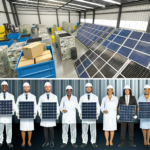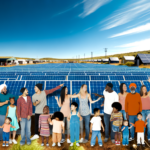Introduction
Overview of Community Solar Initiatives
Community solar initiatives are collaborative projects that allow multiple participants to share the benefits of a single solar power system. Unlike traditional solar installations, which are typically mounted on individual homes or businesses, community solar projects are often located on a central site such as a large rooftop, a field, or a parking lot. These projects enable individuals, businesses, and organizations to invest in solar energy without the need for their own solar panels. Participants can purchase or lease a portion of the solar array, and in return, they receive credits on their electricity bills for the power generated by their share of the system.
Community solar initiatives are gaining traction across the United States as a viable solution for expanding access to renewable energy. They offer a practical way for people who may not have suitable rooftops, who rent their homes, or who cannot afford the upfront costs of solar panels to participate in the clean energy movement. By pooling resources and sharing the benefits, community solar projects democratize access to solar power and contribute to a more sustainable energy future.
Importance of Sustainable Energy Solutions
The urgency of transitioning to sustainable energy solutions cannot be overstated. Fossil fuels, which currently dominate global energy production, are the largest contributors to greenhouse gas emissions and climate change. According to the United Nations, fossil fuels account for over 75% of global greenhouse gas emissions and nearly 90% of all carbon dioxide emissions. To mitigate the worst impacts of climate change, it is imperative to reduce these emissions by almost half by 2030 and achieve net-zero emissions by 2050.
Renewable energy sources such as solar, wind, and hydropower offer a path to a cleaner, more sustainable future. These sources are abundant, replenished by nature, and emit little to no greenhouse gases or pollutants. By investing in renewable energy, we can reduce our dependence on fossil fuels, improve air quality, create jobs, and drive economic growth. Community solar initiatives play a crucial role in this transition by making renewable energy more accessible and affordable for a broader segment of the population.
Purpose and Scope of the Article
The purpose of this article is to provide a comprehensive guide to community solar initiatives and their role in promoting a sustainable energy future. We will explore the concept of community solar, how it works, and the different types of projects available. Additionally, we will delve into the numerous benefits of joining community solar initiatives, including environmental, economic, and social advantages.
The article will also offer practical advice on how to get involved in community solar, from finding local projects to understanding subscription models and evaluating costs and savings. We will address common challenges and provide strategies for overcoming financial, regulatory, and performance-related barriers. To illustrate the real-world impact of community solar, we will share case studies and success stories from across the United States.
Finally, we will conclude with a call to action, encouraging individuals and communities to embrace community solar as a means to empower themselves and contribute to a sustainable tomorrow. By the end of this article, readers will have a clear understanding of the potential of community solar initiatives and the steps they can take to participate in this transformative movement.
Understanding Community Solar
What is Community Solar?
Community solar refers to a solar power plant whose electricity is shared by more than one household. This model allows individuals, businesses, and organizations to benefit from solar energy without having to install solar panels on their own properties. Instead, participants subscribe to a portion of the energy produced by a local solar facility and receive credits on their electricity bills for their share of the power generated. This approach democratizes access to renewable energy, making it possible for renters, apartment dwellers, and those with unsuitable rooftops to participate in the solar revolution.
How Community Solar Works
Community solar projects operate on a subscription basis. Here’s a step-by-step breakdown of how it works:
1. **Development**: A solar developer or a community organization identifies a suitable location for a solar array, such as a large rooftop, open field, or brownfield site.
2. **Construction**: The solar array is constructed, often with the help of local labor and community involvement.
3. **Subscription**: Community members can subscribe to a portion of the solar array’s output. Subscriptions can be tailored to meet individual energy needs and budgets.
4. **Energy Production**: The solar array generates electricity, which is fed into the local power grid.
5. **Bill Credits**: Subscribers receive credits on their electricity bills based on the amount of solar energy produced by their share of the array. These credits reduce their overall electricity costs.
This model not only provides access to clean energy but also simplifies the process by eliminating the need for individual maintenance and installation.
Types of Community Solar Projects
Community solar projects can vary widely in their structure and implementation. Here are some common types:
1. **Utility-Sponsored Projects**: These are initiated and managed by utility companies. Subscribers can purchase or lease a portion of the solar array’s output directly from the utility. This model often benefits from streamlined billing and customer service.
2. **Special Purpose Entities (SPEs)**: In this model, a group of investors or community members forms a legal entity to develop and manage the solar project. Participants buy shares in the SPE and receive a portion of the energy produced.
3. **Non-Profit Models**: Non-profit organizations develop and manage the solar array, often focusing on providing benefits to low-income households and community institutions. These projects may rely on grants, donations, and volunteer labor to reduce costs.
4. **Cooperative Models**: Similar to non-profit models, cooperatives are member-owned organizations that develop and manage the solar project. Members purchase shares and have a say in the project’s operations and governance.
Each type of community solar project has its own advantages and challenges, but all share the common goal of making solar energy more accessible and equitable. By understanding these different models, communities can choose the approach that best fits their needs and resources.
Benefits of Joining Community Solar Initiatives
Environmental Benefits
Community solar initiatives offer significant environmental advantages. By harnessing the power of the sun, these projects reduce reliance on fossil fuels, which are major contributors to greenhouse gas emissions and climate change. Solar energy is a clean, renewable resource that produces no air or water pollution. By participating in community solar, individuals and businesses can significantly lower their carbon footprint. For instance, Maryland’s community solar projects have already generated over 1,283 GWh of clean electricity, demonstrating the substantial environmental impact these initiatives can have.
Economic Advantages
Joining a community solar initiative can also provide numerous economic benefits. For property owners, leasing roof space for solar panels can create a new revenue stream, effectively increasing the net operating income of the property. This is particularly advantageous in states like Maryland, where incentives such as the Solar Renewable Energy Credit (SREC) program can further enhance financial returns. Additionally, community solar projects can offer participants lower electricity rates compared to traditional utility services, leading to significant savings on energy bills. The economic benefits extend to job creation as well, with the development and maintenance of solar projects generating employment opportunities in local communities.
Community and Social Impact
Community solar projects foster a sense of collective responsibility and community engagement. They democratize access to renewable energy, allowing renters, low-income households, and those without suitable rooftops to participate in and benefit from solar power. In Maryland, for example, legislation mandates that at least 40% of community solar capacity be dedicated to low- and moderate-income customers, ensuring that the financial and environmental perks of solar energy are accessible to underserved communities. This inclusivity helps bridge the energy equity gap and promotes social cohesion by bringing diverse groups together to work towards a common goal of sustainability.
Energy Independence and Security
One of the most compelling benefits of community solar is the enhancement of energy independence and security. By decentralizing power production, community solar projects reduce reliance on large utility companies and fossil fuels. This decentralization makes the energy grid more resilient to disruptions, such as natural disasters or technical failures. Participants in community solar projects can enjoy a more stable and predictable energy supply, contributing to overall energy security. Moreover, the local generation of solar power can help stabilize energy prices and reduce the volatility associated with fossil fuel markets.
In summary, joining community solar initiatives offers a multitude of benefits, from environmental sustainability and economic savings to social equity and energy security. These projects not only empower individuals and communities to take control of their energy needs but also contribute to a more sustainable and resilient future.
How to Get Involved in Community Solar
Finding Local Community Solar Projects
Getting involved in community solar starts with finding a project near you. Many states and local governments have online resources and databases that list available community solar projects. Websites like the National Renewable Energy Laboratory (NREL) and local utility companies often provide directories of community solar initiatives. Additionally, community organizations and environmental groups can be valuable resources for discovering local projects.
Steps to Join a Community Solar Initiative
Once you’ve identified a local community solar project, the next steps typically involve:
- Research: Gather information about the project, including its size, location, and the benefits it offers.
- Contact the Provider: Reach out to the project provider or developer to express your interest and ask any questions you may have.
- Review the Agreement: Carefully read the subscription agreement or contract to understand the terms, including costs, savings, and the duration of your commitment.
- Sign Up: Complete the necessary paperwork to become a subscriber. This may involve providing your utility account information and agreeing to the terms of the subscription.
- Enjoy the Benefits: Once you’re enrolled, you’ll start receiving credits on your electricity bill for your share of the solar energy produced.
Understanding Subscription Models
Community solar projects typically offer different subscription models to accommodate various needs and preferences:
- Ownership Model: Participants purchase a share of the solar panels and receive credits based on the energy produced by their share. This model often requires a higher upfront investment but can offer long-term savings.
- Subscription Model: Participants subscribe to a portion of the solar energy produced by the project and pay a monthly fee. This model usually has lower upfront costs and provides immediate savings on electricity bills.
- Pay-As-You-Go: Some projects offer a pay-as-you-go option, where participants pay for the solar energy they use each month without a long-term commitment.
Understanding these models can help you choose the one that best fits your financial situation and energy needs.
Evaluating Costs and Savings
Before joining a community solar project, it’s essential to evaluate the costs and potential savings:
- Upfront Costs: Determine if there are any initial fees or costs associated with joining the project.
- Monthly Fees: Understand the monthly subscription fees and how they compare to your current electricity costs.
- Bill Credits: Calculate the expected credits on your electricity bill based on your share of the solar energy produced.
- Long-Term Savings: Consider the long-term financial benefits, including potential increases in electricity rates and the duration of the project.
By carefully evaluating these factors, you can make an informed decision and maximize the benefits of participating in a community solar initiative.
Overcoming Common Challenges
Addressing Financial Barriers
One of the most significant obstacles to joining community solar initiatives is the upfront cost. Many potential participants are deterred by the initial investment required for solar projects. However, there are several strategies to mitigate these financial barriers:
- Government Incentives and Grants: Many governments offer incentives, tax credits, and grants to reduce the financial burden on participants. These can significantly lower the initial costs and make community solar more accessible.
- Financing Options: Various financing models, such as loans, leases, and power purchase agreements (PPAs), allow participants to spread the cost over time. This makes it easier for individuals and businesses to join without a substantial upfront payment.
- Community Funding: Crowdfunding and cooperative models enable communities to pool resources, making it possible for even low-income households to participate in solar projects.
Navigating Regulatory and Policy Issues
Regulatory and policy challenges can also hinder the development and participation in community solar projects. These issues vary by region but often include complex permitting processes, grid interconnection standards, and utility regulations. To navigate these challenges:
- Advocacy and Policy Engagement: Engaging with local and state policymakers to advocate for supportive regulations can help create a more favorable environment for community solar. This includes pushing for streamlined permitting processes and fair compensation for solar energy fed into the grid.
- Partnerships with Utilities: Collaborating with utility companies can facilitate smoother integration of community solar projects into the existing grid. Utilities can provide valuable support in terms of technical expertise and infrastructure.
- Legal and Technical Assistance: Access to legal and technical expertise can help navigate the regulatory landscape. Organizations and consultants specializing in renewable energy can offer guidance on compliance and best practices.
Ensuring Project Reliability and Performance
The reliability and performance of community solar projects are crucial for their long-term success. Participants need assurance that their investment will yield consistent and reliable energy. To ensure project reliability:
- Quality Equipment and Installation: Using high-quality solar panels and components, along with professional installation, can significantly enhance the reliability and efficiency of the system.
- Regular Maintenance and Monitoring: Implementing a robust maintenance and monitoring plan ensures that the system operates at peak performance. Regular inspections and timely repairs can prevent minor issues from becoming major problems.
- Performance Guarantees: Offering performance guarantees or warranties can provide participants with confidence in the project’s long-term viability. These guarantees often cover aspects like energy production levels and equipment durability.
- Transparent Reporting: Providing transparent and regular reports on the project’s performance helps build trust among participants. This includes sharing data on energy production, savings, and any maintenance activities.
By addressing these common challenges, community solar initiatives can become more accessible, reliable, and effective in promoting sustainable energy solutions. Overcoming financial, regulatory, and performance-related obstacles is essential for empowering communities to take part in the renewable energy transition.
Case Studies and Success Stories
Successful Community Solar Projects in the U.S.
Community solar projects have been gaining traction across the United States, demonstrating the potential for renewable energy to transform local communities. One notable example is the **Solar United Neighbors (SUN)** initiative, which has successfully launched community solar projects in multiple states, including Maryland, Florida, and Minnesota. These projects have enabled thousands of residents to access solar energy without the need for individual rooftop installations, significantly reducing their carbon footprints and energy bills.
Another exemplary project is the **Arcadia Power Community Solar Program**. Operating in states like New York and Colorado, Arcadia Power allows residents to subscribe to local solar farms. Subscribers receive credits on their utility bills for the energy produced by their share of the solar farm, making it an attractive option for renters and homeowners alike.
Personal Stories from Community Solar Participants
The impact of community solar initiatives is best illustrated through the personal stories of participants. **Jane Thompson**, a resident of Denver, Colorado, joined a community solar project through Arcadia Power. “I live in an apartment and never thought I could benefit from solar energy,” Jane shares. “But now, I see a reduction in my energy bills every month, and it feels great to contribute to a cleaner environment.”
In Maryland, **Carlos Rodriguez** became a member of a Solar United Neighbors co-op. “The process was straightforward, and the savings are real,” Carlos explains. “It’s empowering to know that my family is part of a larger movement towards sustainable energy.”
Lessons Learned and Best Practices
The success of community solar projects across the U.S. offers valuable lessons and best practices for future initiatives:
1. **Community Engagement**: Effective community solar projects prioritize engaging local residents and stakeholders from the outset. This includes educational workshops, transparent communication, and opportunities for community input.
2. **Flexible Subscription Models**: Offering various subscription models, such as pay-as-you-go or fixed-rate plans, can accommodate different financial situations and increase participation rates.
3. **Partnerships with Local Organizations**: Collaborating with local non-profits, government agencies, and businesses can enhance project credibility and reach. For instance, partnerships with local utilities can streamline the integration of solar credits into utility bills.
4. **Regulatory Support**: Navigating regulatory landscapes is crucial. Successful projects often work closely with policymakers to advocate for supportive regulations and incentives that facilitate community solar development.
5. **Scalability and Replicability**: Designing projects with scalability in mind ensures that successful models can be replicated in other communities. This includes standardized processes for site selection, permitting, and customer acquisition.
By learning from these case studies and personal experiences, communities can better implement and benefit from solar initiatives, paving the way for a more sustainable and inclusive energy future.
Conclusion
Recap of Key Points
As we have explored throughout this article, community solar initiatives represent a transformative approach to harnessing solar energy. These projects democratize access to renewable energy, making it possible for individuals who may not have suitable rooftops or the financial means for individual installations to participate in the solar revolution. The benefits are multifaceted, encompassing environmental sustainability, economic advantages, community empowerment, and enhanced energy security. By decentralizing power production, community solar projects reduce reliance on fossil fuels and large utility companies, fostering a more resilient and independent energy landscape.
The Future of Community Solar
The future of community solar is bright and promising. As technology advances and costs continue to decline, the accessibility and efficiency of solar energy will only improve. Policy support and innovative financing models will play crucial roles in overcoming existing barriers, making it easier for more communities to adopt these initiatives. Globally, countries like the USA, India, and those in the European Union are setting ambitious targets for renewable energy, with community solar poised to be a cornerstone of these efforts. The continued growth of community solar projects will contribute significantly to global sustainability goals, reducing carbon footprints and mitigating the impacts of climate change.
Call to Action: Empowering Communities for a Sustainable Tomorrow
Now is the time to act. By joining or supporting community solar initiatives, you can be part of a movement that not only benefits you personally but also contributes to a larger, global effort towards sustainability. Here are a few steps you can take:
- Educate Yourself and Others: Learn about local community solar projects and share this knowledge with your community.
- Get Involved: Participate in local initiatives, attend meetings, and advocate for supportive policies.
- Invest in Community Solar: Consider subscribing to a community solar project or investing in one if you have the means.
- Support Policy Changes: Advocate for policies that support renewable energy and community solar projects at local, state, and national levels.
By taking these steps, you can help ensure that community solar becomes a widespread, viable option for clean energy. Together, we can empower our communities, reduce our environmental impact, and create a sustainable future for generations to come. The power is truly in our hands—let’s harness it for a brighter tomorrow.






